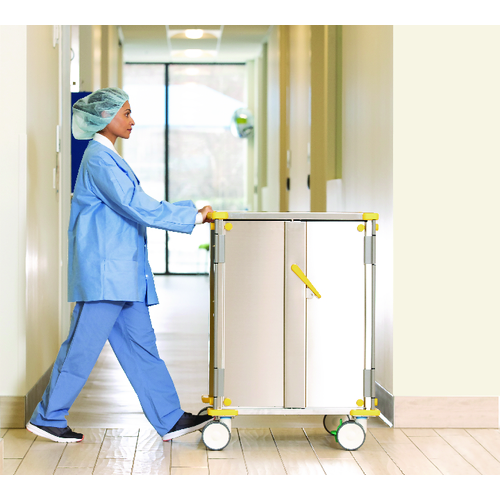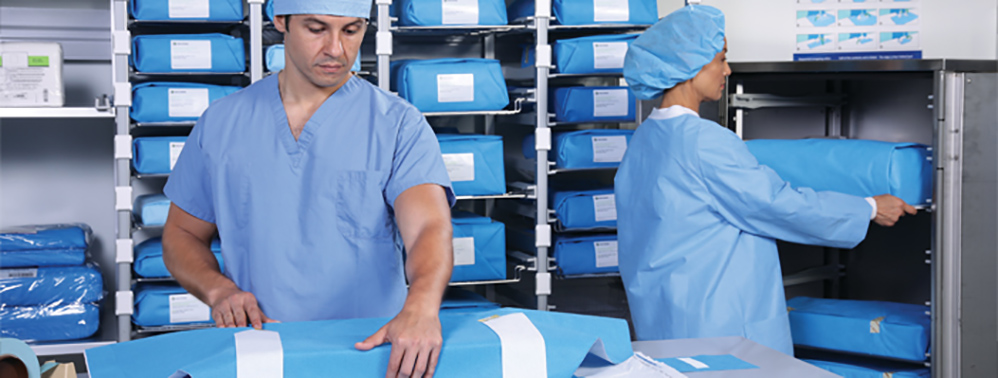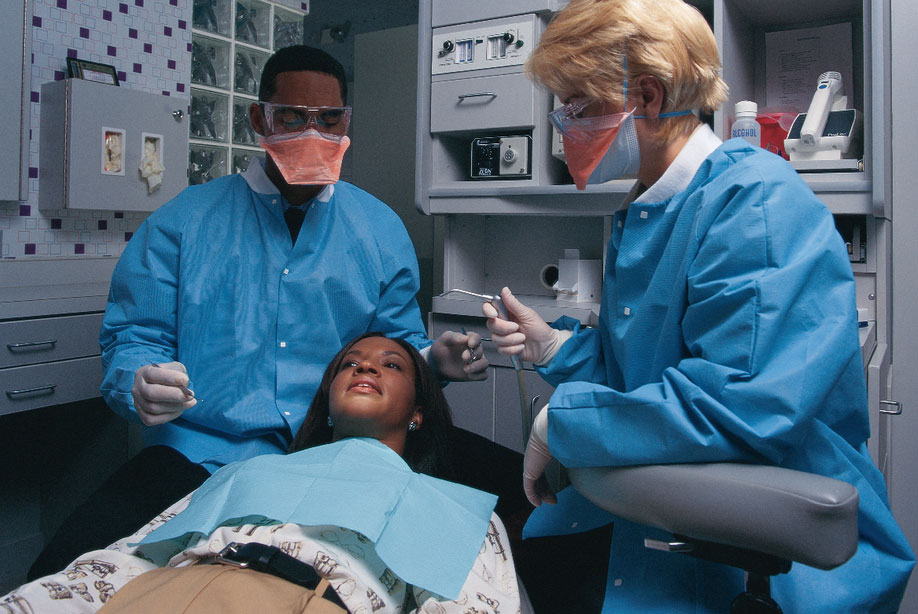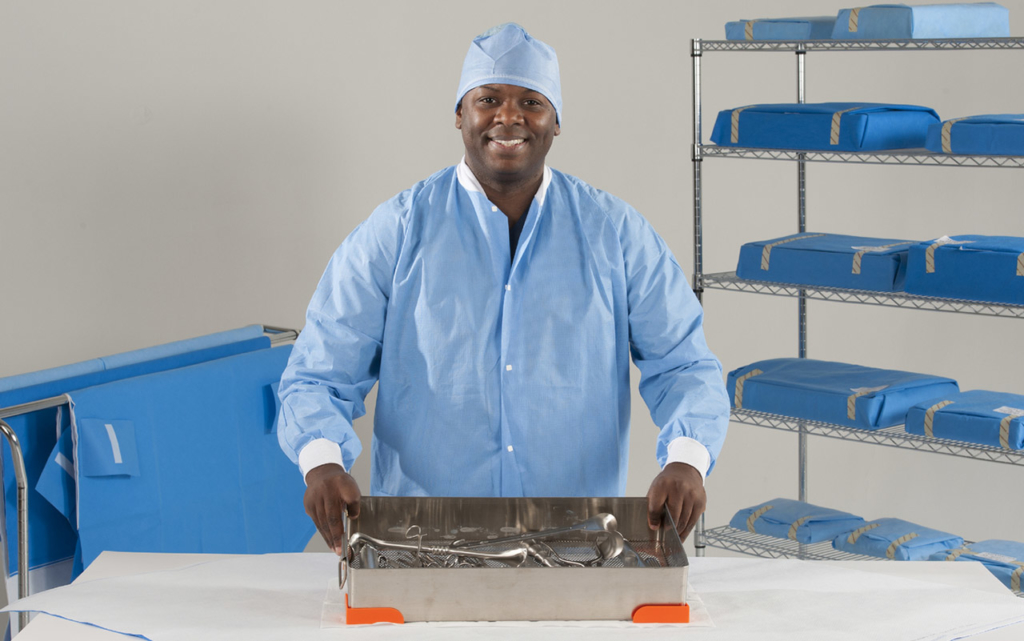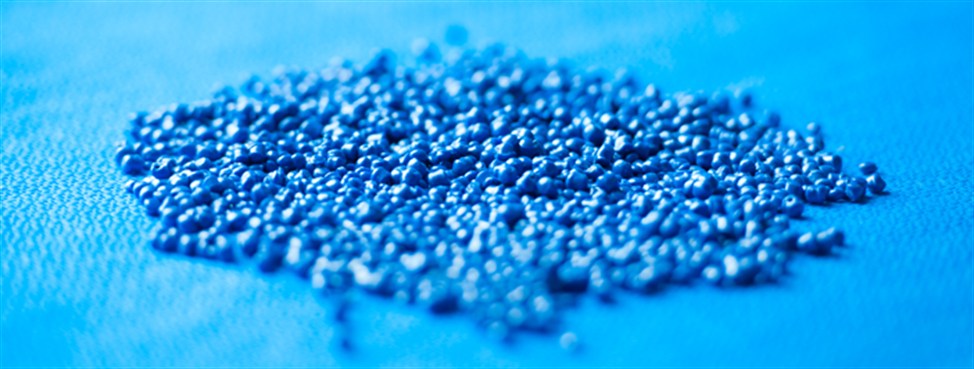Sterilization pouches are the small but mighty protector in sterile processing departments (SPDs) worldwide. While they may not be as widely discussed as sterile wrap or containers, sterilization pouches play a key role in sterilizing reusable devices – contributing to an environment of safe and quality patient care.
What is a single-use sterilization pouch?
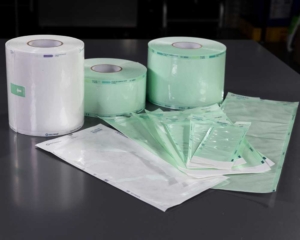 A single-use sterilization pouch is designed for sterilizing reusable, lightweight surgical instruments and has varying purposes within the healthcare setting. Since all equipment used within an operating room must be sterilized, back up scissors, forceps, orclamps are often sterilized in pouches. Sterilization pouches are also used for unique or specialty instruments with limited use or inventory. Clinics and other procedural areas receive single-use sterilization pouches containing reprocessed surgical instruments needed for patient use from medical equipment kitting and sterilizer facilities. Sterilization pouches are designed for single use in order to prevent any contamination in the sterilization process.
A single-use sterilization pouch is designed for sterilizing reusable, lightweight surgical instruments and has varying purposes within the healthcare setting. Since all equipment used within an operating room must be sterilized, back up scissors, forceps, orclamps are often sterilized in pouches. Sterilization pouches are also used for unique or specialty instruments with limited use or inventory. Clinics and other procedural areas receive single-use sterilization pouches containing reprocessed surgical instruments needed for patient use from medical equipment kitting and sterilizer facilities. Sterilization pouches are designed for single use in order to prevent any contamination in the sterilization process.
The sterilization process using a pouch
When it comes to using a sterilization pouch, the process is relatively simple. Before items are placed into a pouch, they are decontaminated and cleaned and should be dry and free of any visible soil or debris. The items are then placed into the appropriate pouch, allowing enough space between them for adequate sterilant penetration during sterilization. Once the items are correctly positioned in the pouch, a chemical indicator (Steam -Type 5 Integrator and Low-Temp Type 4 and Type 1) is added and the pouch is sealed, either by a self-seal or heat seal method. It is important to follow the manufacturer’s instructions, as sealing the pouch creates the correct closure needed to maintain the sterility of the pouches’ contents. After labeling the sealed pouch and documenting any relevant information, the pouch is placed in a designated container or tray to be transported to the sterilization area. Then it is time for sterilization, which will follow the manufacturer’s instructions for the specific sterilization cycle recommended for pouches’ contents.
According to the Association of periOperative Registered Nurses’ (AORN) guidelines1, peel pouches should be placed on an edge and spaced to permit sterilant contact and drying when loading the sterilizer. Racks should be used that are designed and intended for sterilization to separate and hold pouches in a vertical position as needed. Additionally, when there is an indication of double pouching, verify that the inner pouch fits within the outer pouch without folding and faces in the same direction as the outer pouch (i.e., plastic or PET faces plastic or PET, and the paper or Tyvek® faces paper or Tyvek®). After the completion of the sterilization process, pouches can be stored within designated areas of the SPD, following appropriate storage conditions and rotation practices, until they are ready to be taken to the OR for aseptic opening.
Sterilization Pouch Design
To ensure the ease of identifying the instrument(s) inside the pouch, pouches are designed by sealing a clear plastic material and a permeable / porous (paper or Tyvek®) material together. The clear plastic side acts as a window while the paper or Tyvek® side is essential for sterilant to ingress and egress into the sterilization process. The paper side serves as a breathable barrier, allowing for the penetration of sterilization agents while acting as a barrier against bacteria, dust and other contaminants to prevent the ingress of microorganisms post sterilization and storage. It also helps control moisture levels during the sterilization process, which is crucial for the effectiveness of various sterilization methods, such as steam sterilization. The paper material should be tear resistant, low linting, with effective filtration efficiency to maintain the integrity of the sterilization packaging until the items are ready to be used.
Types of single-use sterilization pouches
In order to accommodate all shapes and sizes of reusable surgical instruments that require sterilization, single-use sterilization pouches come in a variety of options – including pre-sized and cut-to-size pouches. Pouches can be purchased pre-sized to specific dimensions or purchased in rolls, which are cut-to-size by the end user. Pre-sized pouches can improve efficiency in packaging once the correct size is identified, while cut-to-size rolls provide more flexibility in variation between instruments.
Ensuring the correct size of pouch, regardless of the style used, is an important part of achieving absolute sterility. Having too big or too small of a pouch can cause issues with achieving and maintaining sterility during storage. Sizing pouches correctly is essential to allow for proper air removal, sterilant penetration, and drying. In general, it is recommended that the pouch is not packed too full and that at least 1 inch of space should be left around the item being sealed from all sides.
For a reusable surgical instrument to be considered sterile in a single-use sterilization pouch, the packaging must remain fully sealed during and after the sterilization phase. There are two types of sealing methods for pouches – heat-seal and self-seal. Pre-sized pouches can be purchased with a self-sealing adhesive strip or will require a heat sealer to close off the open end. The heat-sealing option is required for the cut to size rolls.
Self-sealing pouches are faster to use and do not require any additional equipment as a protective backing is removed to expose the adhesive. Heat seal pouches require a sealer, as the name suggests. It will also take time for the machine to heat up before the pouch can be inserted for sealing. However, a benefit for heat sealed pouches is that they are less likely to crease or bubble as the seam is pressed flat and heat sealed, providing better confidence in sterility. It is important that the recommended sealing parameter specified in the IFU is followed along with using verficiation accessories to confirm that the pouches are adequately sealed.
Key SPD considerations for selecting single-use sterilization pouches
SPD staff using single-use sterilization pouches should keep the following considerations top of mind when selecting a pouch to purchase:
- Efficiency or flexibility (pre-sized versus cut to size)
Depending on how busy or large a facility and its SPD may be, the efficiency of pre-sized pouches can be beneficial to cut down on time spent cutting to the correct sizing. If a facility is limited on space, then the cut to size rolls can offer more versatility by having the ability to be used with multiple instrument types. - Self-seal versus heat seal
Whether using self-seal or heat seal, education for frontline technicians will be required. Closing self-seal pouches must be done correctly to ensure no gaps are present in the seal. Similarly, pouches that require a heat seal must be done precisely to ensure a smooth and complete seal. There are tools, such as tape or dye, that can evaluate the seal to help ensure its efficacy and validate the sealing process. - Pouch sizes and storage capacity
Before purchasing every size option available, evaluate which sizes are truly needed and if your facility has the capacity to store the volume of inventory required to stock. Take some instrument measurements and see what will work best for the majority of your needs. - Shelf life and sterility assurance
Consider if the pouch has a shelf life – meaning does the instructions for use (IFU) support event-related sterility or will unused instruments need to be reprocessed after a period of time? This may be referenced as event-related or expiration dating. If a sterilized pouch offers limited sterility, then it will be important to develop a procedure for sterile processing staff to audit and inspect when pouches will be due for reprocessing – these should be developed by the facilities and followed. - Utilization cost
Product costs may vary depending on the type of pouch and size – with larger pouches typically costing more. If utilizing the heat seal option, then there will be the added expense of purchasing and maintaining the heat sealer. To understand your utilization cost, SPD staff should evaluate the estimated usage of the product (i.e., the volume of pouches per month) and compare to the price of the different product types.
Key clinical considerations for selecting single-use sterilization pouches
Perioperative professionals and clinicians receiving the single-use sterilization pouch should consider the following features and attributes when picking products to purchase for their facility:
- Material durability
Understand how durable the pouch material is and if it can withstand tearing from storage and handling. Regardless of the shelf life of the sterilized pouches, the end user also needs to inspect the package integrity before use. Ensuring the package does not have holes or gaps in the seals or breaches is critical for safe patient use. - Sterility reliability
Achieving and maintaining absolute sterility of the instruments is the main goal of sterilization pouches, so it is important to ensure that the sterility is reliable. Many pouches offer features to further safeguard sterility, such as an external indicator to show the difference between processed and unprocessed packaging. For some end users in the operating room, this feature provides additional reassurance of sterility. - Ease of opening
Being able to open a sterilized pouch aseptically is critically important. If a sterilized pouch does not open as intended or easily, then this could compromise the instrument through unintended cross contamination.
Final recommendations
When selecting a single-use sterilization pouch, it is important to ensure the product meets the needs of both those working in the SPD and operating room. In sum, to ensure proper product selection and usage, SPD and perioperative professionals should take the following steps:
- Understand which type of pouch is best suited for the specific surgical instruments being reprocessed and sterilization utilized.
- Determine if pre-sized or cut to size will be needed; or possibly both.
- Decide which pouch-sealing system best serves your facility. If using the heat seal option, ensure the heat sealer is appropriate for the recommended sealing parameters and approved by facility’s biomed resource for use.
- Read the product’s IFU for details related to shelf life, approved sterilization parameters.
- Ensure all staff receive proper education for usage and handling.
For more information on HALYARD* sterilization pouches, please visit: www.halyardhealth.com or call 1-844-HALYARD (1-844-425-9273) in the United States and Canada.
Article Contribution, Sara G. Vinson
Link, Terri. “Guidelines in Practice: Sterilization Packaging Systems.” AORN Journal. Retrieved from https://aornjournal.onlinelibrary.wiley.com/doi/10.1002/aorn.13150. Accessed 15 June 2023.
DuPont™ and Tyvek® are a trademarks or registered trademarks of DuPont de Nemours, Inc
*Registered Trademark or Trademark of O&M Halyard or its affiliates. ©2023. All rights reserved. COPY-0000


